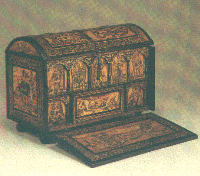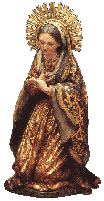 PPLIED
PPLIED  RTS
RTS  N
N  EXICO
EXICO
 |
The mainstay of the museum is composed of
numerous galleries devoted to the applied arts and their
development in Mexico. On display are objects
manufactured in Mexico or those brought here from several
parts of the world, which were adopted to subsequently
form part of Mexico´s own cultural heritage.
Beginning with the 16th century, there is an ample display of furniture imported by Spaniards after the Conquest. The typically Spanish renaissance vargueno (a hutch with numerous compartments and drawers usually set on a tangle), chests, frair´s chairs and tapestries were all part of the essentially austere furnishings of the period. |
Mexican craftsmen soon showed their ability to match the quality of many Spanish products as is true of the silverware made in Mexico during the 16th century.
By the 17th century, a far greater variety of pieces was being manufactured in Mexico, employing a wide gamut of methods and material.
Marked by profusion in design, baroque styles were flourishing throughout the world and eventually made their appearance in Mexico. Furniture was embellished with carving, lacquer and inlay; silver was saturated with engraving and repoussé; ceramics burgeoned in a wealth of form and decoration, and painting and sculpture absorbed the style into richly gilded and ornamented altarpieces.
| Secular life became refined, and a delight in
decoration increased. France contributed the undulating
extravagance of rococo; England the designs of its
cabinetmakers which -though baroque- featured a certain
sobriety; from the Orient came objects made of ivory,
screens, porcelain, silks and lacquers, all of which were
absorbed into the crafts manufactured in New Spain.
It was not until the last quarter of the 17th century when the baroque had reached its extremes of exaggeration, that a reaction to its excess appeared as a neoclassical revival. This became particularly apparent in the fine arts and in furniture which (as a complement to architecture) adopted many of its elements, such as columns, friezes and frontispieces. Marquetry was applied to classical forms; and with the advent of Mexico´s Independence, a change in attitude caused an evident nationalism to be apparent in many of the objects produced during the period. |
 |




©Todos los derechos reservados, se prohibe la
reproducción salvo permiso por escrito del autor.
©All rigths reserved, material duplication is prohibited
without written authorization by its author.